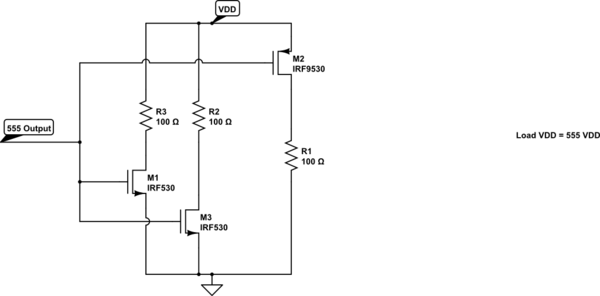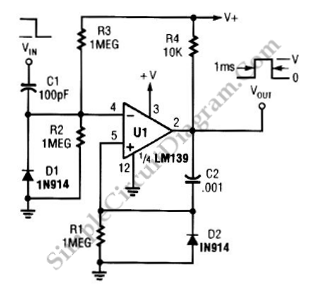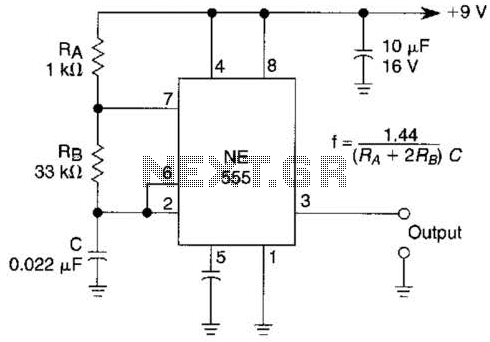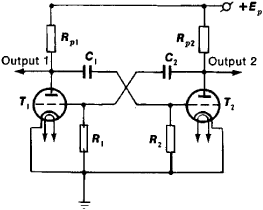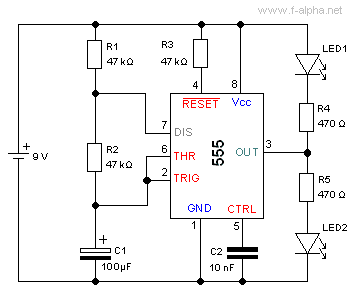
Astable Multivibrator (Oscillator)
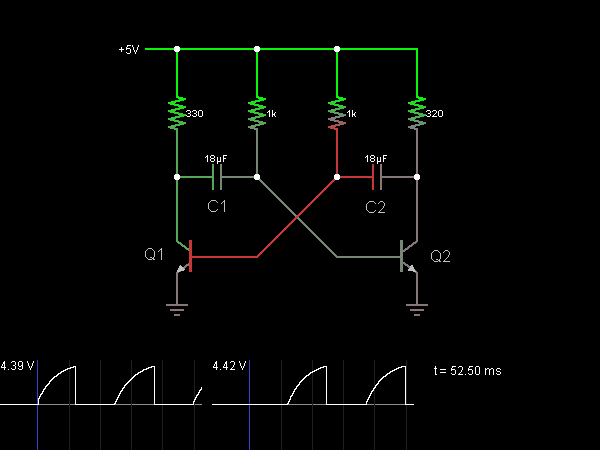
This circuit functions as an astable multivibrator, also known as an oscillator. The two transistors are interconnected in a manner that allows the circuit to alternate between two states. In one state, the base of transistor Q1 is approximately one diode drop above ground, enabling base current to flow. This keeps Q1 in saturation mode, allowing current to pass through the collector and maintaining a low collector voltage while discharging capacitor C1. Transistor Q2 remains off since its base voltage is insufficient to turn it on. As the collector current of Q1 charges capacitor C1, the base voltage of Q2 rises until it reaches the threshold to activate Q2, resulting in current flowing through its collector. This current causes a voltage drop across the resistor connected above it, lowering the collector voltage. Consequently, the voltage on the right side of capacitor C2 decreases, but since the voltage across C2 remains unchanged, this leads to a drop in the base voltage of Q1 below ground, turning it off.
The astable multivibrator circuit described operates continuously, producing a square wave output without requiring any external triggering. The primary components involved are two NPN transistors (Q1 and Q2), two capacitors (C1 and C2), and resistors that set the timing characteristics of the oscillation.
In a typical configuration, resistors R1 and R2 are connected to the base of each transistor to limit the base current and establish the switching thresholds. The capacitors C1 and C2 are responsible for timing the transitions between the two states. When Q1 is active, it charges C1, and as C1 reaches a certain voltage, it triggers Q2, which then pulls the base of Q1 low, causing it to turn off. This feedback loop creates a continuous oscillation.
The frequency of oscillation can be calculated using the values of the resistors and capacitors in the circuit. The formula for the frequency (f) is given by:
f = 1 / (ln(2) * (R1 + R2) * C1)
This equation highlights the relationship between the resistor and capacitor values and the frequency of the output waveform. The duty cycle of the output can also be adjusted by varying the resistor values, allowing for customization of the output signal characteristics.
The output of the circuit can be taken from the collector of either transistor, providing a square wave signal that can be used for various applications, including clock pulses for digital circuits, tone generation, or as a basic timer. Overall, the astable multivibrator is a fundamental building block in electronic design, illustrating the principles of feedback and oscillation in transistor-based circuits.This circuit is an astable multivibrator, or oscillator. The two transistors are cross-coupled in such a way that the circuit switches back and forth between two states. In one state, the base of Q1 is about one diode drop above ground, allowing a base current to flow. This keeps Q1 switched on, in saturation mode, allowing a current to flow throu gh the collector, keeping Q1`s collector voltage low, and discharging C1. Q2 is switched off, because its base voltage is not high enough to switch it on. As the collector current into Q1 charges C1, the base voltage for Q2 goes up, until it is high enough to switch on Q2, causing a current to flow through its collector, which drops the collector voltage (the current causes a voltage drop across the resistor above it). The right side of C2 has dropped, but the voltage across it hasn`t changed, so this causes Q1`s base voltage to drop below ground, switching it off.
🔗 External reference
The astable multivibrator circuit described operates continuously, producing a square wave output without requiring any external triggering. The primary components involved are two NPN transistors (Q1 and Q2), two capacitors (C1 and C2), and resistors that set the timing characteristics of the oscillation.
In a typical configuration, resistors R1 and R2 are connected to the base of each transistor to limit the base current and establish the switching thresholds. The capacitors C1 and C2 are responsible for timing the transitions between the two states. When Q1 is active, it charges C1, and as C1 reaches a certain voltage, it triggers Q2, which then pulls the base of Q1 low, causing it to turn off. This feedback loop creates a continuous oscillation.
The frequency of oscillation can be calculated using the values of the resistors and capacitors in the circuit. The formula for the frequency (f) is given by:
f = 1 / (ln(2) * (R1 + R2) * C1)
This equation highlights the relationship between the resistor and capacitor values and the frequency of the output waveform. The duty cycle of the output can also be adjusted by varying the resistor values, allowing for customization of the output signal characteristics.
The output of the circuit can be taken from the collector of either transistor, providing a square wave signal that can be used for various applications, including clock pulses for digital circuits, tone generation, or as a basic timer. Overall, the astable multivibrator is a fundamental building block in electronic design, illustrating the principles of feedback and oscillation in transistor-based circuits.This circuit is an astable multivibrator, or oscillator. The two transistors are cross-coupled in such a way that the circuit switches back and forth between two states. In one state, the base of Q1 is about one diode drop above ground, allowing a base current to flow. This keeps Q1 switched on, in saturation mode, allowing a current to flow throu gh the collector, keeping Q1`s collector voltage low, and discharging C1. Q2 is switched off, because its base voltage is not high enough to switch it on. As the collector current into Q1 charges C1, the base voltage for Q2 goes up, until it is high enough to switch on Q2, causing a current to flow through its collector, which drops the collector voltage (the current causes a voltage drop across the resistor above it). The right side of C2 has dropped, but the voltage across it hasn`t changed, so this causes Q1`s base voltage to drop below ground, switching it off.
🔗 External reference
